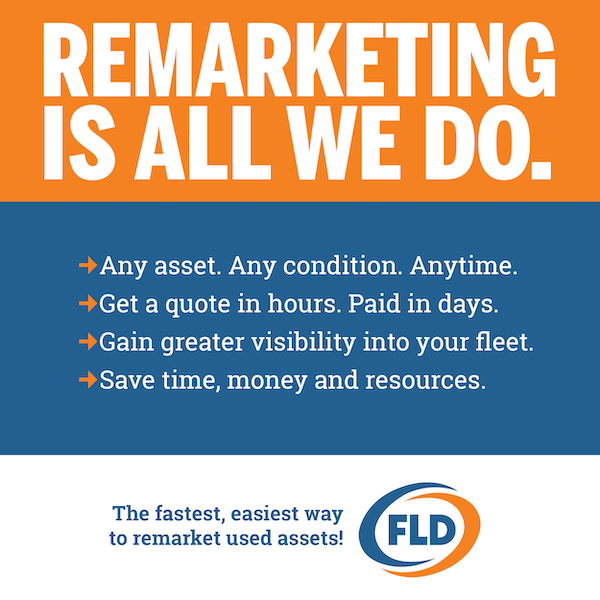
By Bill Bishop, SVP of Sales and Marketing, FLD Remarketing
January 17, 2024
Over the past 5 years, I’ve been fortunate to develop a year-end review – and look at the year ahead – for the readers of Fleet Management Weekly, and am proud to have that opportunity again as we start 2024. As it does every year, my report takes an in-depth look at the wholesale used vehicle market, as well as some of the important factors driving the fleet industry. During the time I’ve been writing this piece, our industry has certainly experienced a formidable host of challenges, as I believe we will in 2024, as EV integration, sky high interest rates, the domestic and global political situation, and industry disruption continue unabated.
That said, as I sit down to pen this year’s version, I’m somewhat encouraged by what I am seeing and feeling across the industry – although certainly not by everything. While I’d be hard pressed to predict a return to pre-pandemic glory days, there are several positive movements in the market. For one thing, high quality assets are still bringing solid prices at auction, while export markets – for the most part – remain strong. And while fleets may have gotten used to the top-tier resale prices we saw between 2019-2022, it’s important to remember that many vehicles have been on the road 12 to 24 months longer than expected. And working through the inventory glut caused by the pandemic could be painful, as well.
 That said, the reset we’re experiencing now is similar to what the Federal Reserve is trying to do by raising interest rates. It’s going to take some time to work itself out, but it likely means that 2024 could be the year we round the corner and fall back into more predictable patterns. With that in mind, here’s my look back at the wholesale vehicle market in 2023 and, next week in part 2, a few predictions for where I think it’s headed in 2024.
That said, the reset we’re experiencing now is similar to what the Federal Reserve is trying to do by raising interest rates. It’s going to take some time to work itself out, but it likely means that 2024 could be the year we round the corner and fall back into more predictable patterns. With that in mind, here’s my look back at the wholesale vehicle market in 2023 and, next week in part 2, a few predictions for where I think it’s headed in 2024.
2023: Like Three Years Rolled into One with Three Distinct Segments
In the first third of the year, the used vehicle market rolled along nicely, with both wholesale volume and pricing tracking similar to what we saw in 2022. And while there may have been a small bump in the road here or there, those patterns held fairly steady right up until the end of April, falling back into a narrow range the few times they got slightly off kilter.
Unfortunately, that four months of relative calm was the last time 2023 seemed anything like normal, with the price of wholesale vehicles suddenly falling 10% between the last week of April and the beginning of June. During the next 2-3 months – while nowhere near as drastic as May – prices floated downward, further eroding confidence and casting doubt over what everyone hoped would be a fairly benign year.
 By September, used vehicle prices were in a freefall with virtually every segment of the white metal market, taking a significant hit. Suddenly, assets that many fleets had been forced to hold, due to a lack of new vehicles, had lost anywhere from 10% to 35% in just a few months.
By September, used vehicle prices were in a freefall with virtually every segment of the white metal market, taking a significant hit. Suddenly, assets that many fleets had been forced to hold, due to a lack of new vehicles, had lost anywhere from 10% to 35% in just a few months.
In Q4, most segments of the market fell even further, with some wholesale vehicles worth less than 50% of what they were a year ago, and still others bringing little or no interest from buyers who had been actively purchasing in the first third of the year. In fact, when we take a look at the wider market, there are several classes of vehicles that will have trouble selling even at drastically reduced prices despite being roadworthy.
As we look back on 2023, I would say the best way to characterize the wholesale used market as unsettled with a lack of demand, with buyers generally purchasing based only on need. As the year ended and with new vehicle availability picking up, it’s likely we’re at the bottom of the market – hopefully poised to see both prices and volume move back up.
Here’s a quick overview of how each class of used work trucks fared in 2023:
Sleeper Trucks and Day Cabs
The hardest hit segment of the market, sleeper trucks, have dropped in price significantly in just the last couple of months. And while high quality units with low miles are still bringing solid interest at auction, some makes and models that were selling easily in the first third of 2023, receive little or no interest today, and are down as much as 60% year-over-year.
Such low valuations can make it hard to justify the price to prep and re-locate them. This was challenging to do in 2023, as demand for rail cars, transports, and driveaway services were at all-time highs. For their part, day cabs hardly faired better, down 50% from a year ago, with little impetus to reverse course to start the new year.
Class 6, 7 and 8
 Perhaps not as hard hit as the semi units, class 6-8 vehicles have dropped anywhere from 40% to 45% in a year, a significant chunk of money for fleets that were forced to hold these assets longer than planned. And while the 2024 outlook for these vehicles is a bit murkier, the fact that demand for freight continues to be soft makes me think prices for this vehicle class will continue south. And with higher interest rates continuing to slow the housing market, it’s likely the lack of demand for materials handling will continue, meaning prices could have further to drop than the 25% they fell in just the last 4 months of 2023 alone.
Perhaps not as hard hit as the semi units, class 6-8 vehicles have dropped anywhere from 40% to 45% in a year, a significant chunk of money for fleets that were forced to hold these assets longer than planned. And while the 2024 outlook for these vehicles is a bit murkier, the fact that demand for freight continues to be soft makes me think prices for this vehicle class will continue south. And with higher interest rates continuing to slow the housing market, it’s likely the lack of demand for materials handling will continue, meaning prices could have further to drop than the 25% they fell in just the last 4 months of 2023 alone.
Class 3 – 5
Despite high demand for many of the service providers that use these vehicles, class 3 to 5 units fell anywhere from 30% to 35% in 2023. A seriously significant hit over what we’ve seen in a normal year, but still nowhere near as drastic as bigger units. And while new vehicle availability has been a problem since the pandemic, our Customer Advisory Board tells us that for the most part they are expecting delivery of the majority of the 3-5 class trucks on order, something that could further pressure wholesale pricing while potentially flooding the used market.
Class 1 and 2
For the most part, Class 1 and 2 vehicles took nowhere near the beating larger units did, with most falling anywhere from 20% to 25% – and some units not even that much. And while the price of used cars was still down in 2023, most fell anywhere from 15% – 18%, a reversal of course from what we experienced the last few years when used cars were not only in short supply, but historically pricey.
Traditional Indicators are now Murky, Erratic
Over the nearly 10 years that our team has been producing our quarterly White Metal Market Report, we’ve leveraged a host of traditional economic indicators to gauge the health and veracity of the wholesale used vehicle market, as well as give us an indication of where it might be headed in the future. These indicators, which for the most part have been fairly reliable, include the strength of the US dollar, housing starts, the unemployment rate, and the price of crude oil. These days – as the saying goes – forget about it.
 For example, increased activity in the housing sector generally meant an uptick in both the demand and price of used white metal. But while developers are in the process of completing 1 million new rental units – with 600,000 more planned to complete construction in 2024 according to realpage.com, that activity is not driving the kind of robust volume – or pricing – our team would have traditionally predicted.
For example, increased activity in the housing sector generally meant an uptick in both the demand and price of used white metal. But while developers are in the process of completing 1 million new rental units – with 600,000 more planned to complete construction in 2024 according to realpage.com, that activity is not driving the kind of robust volume – or pricing – our team would have traditionally predicted.
Instead, Class 3 to 5 cutaway vans were down hard in the last quarter, as was the demand for 16-foot cutaway van – units we would have expected to increase in value with so much construction going on nationwide. This is further indication that the price for most vehicle classes will not approach some of the sky-high valuations we saw up until April 2022.
Making matters worse – interest rates have more than doubled since January, restricting access to financing and leaving companies cash-strapped. And while some lenders are offering better rates in an attempt to jump start business, the economy remains strong, and we expect the Federal Reserve will be hesitant to go all in on rate decreases for fear of overheating the markets.
Your Partner in a Better Remarketing Experience
Regardless of where things are headed in 2024, our team at FLD is looking forward to what’s in store. We invite you to follow along by emailing us at [email protected] to sign up for our free quarterly White Metal Market Report, an in depth look at the factors driving vehicle remarketing and the wholesale used vehicle market.
If we were to give fleets one piece of remarketing advice as we head into 2024: Don’t wait to sell used assets.
Not at a time when so many unforeseen factors could end up costing your fleet literally millions of dollars, just like it did the ones who held on to used vehicles when we implored customers to begin selling at the top of the used market in April 2022.
Don’t get caught holding used assets that – as we’ve seen over the last year – could end up being worthless. Especially at a time when new vehicle allotments are returning to normal, and fleets need to prepare for the brave new world ahead. Doing so could be disastrous.
Call the seasoned experts at FLD: Remarketing is all we do. We won’t let you down.
 Our only goal is to help make your life easier while saving you a meaningful amount of time, money and resources. We’ll give you a quote on any used asset in hours and get you paid in one fast, easy transaction that takes about a week.
Our only goal is to help make your life easier while saving you a meaningful amount of time, money and resources. We’ll give you a quote on any used asset in hours and get you paid in one fast, easy transaction that takes about a week.
And with our proprietary OVRView app – you can manage your entire remarketing universe from any device, anywhere, anytime it’s convenient for you – it’s just that easy?
To learn more, give us a call at 1-800-754-1522, or email [email protected] for a free 5-minute assessment of your remarketing landscape.
To read Part 2, ‘The 2024 Outlook for the Wholesale Used Work Vehicle Market’, click here.
About the author
 Bill Bishop is SVP of Sales and Marketing at FLD Inc. and a recognized expert on the wholesale used vehicle market. He can be reached at [email protected].
Bill Bishop is SVP of Sales and Marketing at FLD Inc. and a recognized expert on the wholesale used vehicle market. He can be reached at [email protected].




